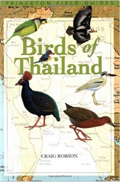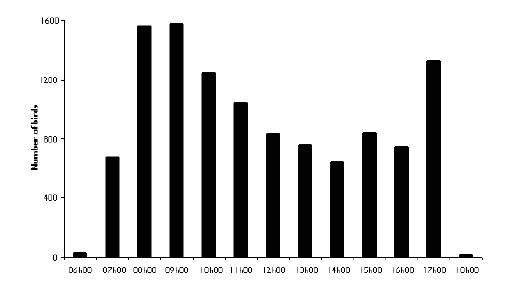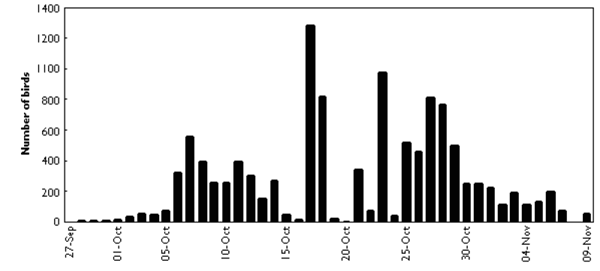
|
||||||||||
|
||||||||||
| Favorite Tweets by @thaibirding | ||||||||||
|
||||||||||
 Buy Birds of Thailand on Amazon.co.uk |
||||||||||
| Site Map ; Contributors |
| Migration
of Black Drongo Dicrurus macrocercus in southern Thailand
in autumn 2003 By Robert DeCandido, Chukiat Nualsri and Deborah Allen |
| Tweet |
| Note:
This article was originally published in Forktail 20 (2004) the journal
of the Oriental
Bird Club (OBC) and was kindly submitted by Robert
DeCandido. Please support the OBC's conservation work by visiting the OBC website and becoming a member. |
| INTRODUCTION The Black Drongo Dicrurus macrocercus is a mediumsized passerine of temperate and tropical Asia. It breeds in south-east Iran, Afghanistan, India, south-east Tibet, and from northern China discontinuously south through south-west Thailand, to Bali and Java. Northern populations migrate, wintering at lower altitudes and latitudes, reaching as far south as central India in the west, and Malaysia and Sumatra in the east, where they occur in tropical savanna, grassland and agricultural areas (Jeyarajasingham and Pearson 1999). Little has been published about Black Drongo migration. Historically, the species was considered an ‘extremely abundant’ migrant in September at Beidaihe, China, occurring in ‘huge noisy parties’ (La Touche 1920). In an autumn migration survey of the same area from 1986–1990,Williams (2000) counted a maximum of 452 in 1986, but only 196 in 1990. Melville and Fletcher (1982) counted 1,444 flying west in less than two hours of observation on 14 October 1980 near Bangkok, Thailand. Numbers migrating through, and wintering in, Thailand appear to have declined in recent years (P. Round verbally 2003, D. Wells in litt. 2004). As part of a study of raptor migration through southern Thailand in autumn 2003 (DeCandido et al. 2004), we also counted the number of migrant Black Drongos passing the watch site. |
| METHODS Chumphon (10o28’N 99o13’E; sea level) is a town on the coastal plain of southern Thailand.The north-south Bilauktaung range 35 km to the west funnels many diurnal bird migrants through this 30-km wide coastal plain adjacent to the Gulf of Thailand (Wells 1999, Zalles and Bildstein 2000). The study site (10o28.40’N 99o13.26’E) was in a freshwater marsh at Ban UTapao, Tha Yang subdistrict, 4.6 km east-north-east of Chumphon, and approximately 2 km north-east of the coastal highway. The vegetation comprises primarily sedges Carex spp., rushes Juncus spp. and cat-tails Typha spp. with lone, scattered trees. In clear weather, it is possible to see 10 km to the north-east, 3 km to the east and west, and about 1 km to the south. The location of our watch site was approximately 435 km to the south-south-west of the one used by Melville and Fletcher (1982). Migrating drongos were counted using 10x binoculars by RDC, assisted at times by CN and DA. Count protocols followed those described in Bildstein and Zalles (1995) for raptors.We scanned primarily north for approaching migrants. A bird was counted if it passed across an imaginary east-west line at the watch site. Observations typically began at 07h00 local time and usually ended at or before 17h00.Weather conditions (wind speed, barometric pressure, temperature, humidity) were measured hourly throughout the day with a hand-held ‘weather station’, the Kestrel 4000 (Nielsen-Kellerman Corporation, USA). Wind direction was assessed with a compass.We counted migrants during late September to early November because this period corresponded to the peak of the diurnal bird migration observed in previous years by CN. |
| RESULTS
AND DISCUSSION During 378 hours of observation between 27 September and 9 November 2003, we counted 11,290 migrating Black Drongos (29.9 birds/hour). Drongos migrated throughout the day, primarily between 07h45 and 17h45 (Fig. 1). Between dawn and c.07h30, Black Drongos made short flights from overnight roosts to foraging areas. Most birds began migrating soon after,along with bee-eaters Merops spp. and swallows Hirundiniae, but before the onset of most raptor migration. The daily peak of migration was at 08h00–10h00, when 28% (3,129) of all individuals were counted (37.2 birds/hour). Numbers fell by early afternoon, but increased again in the late afternoon. There was often a large movement at 17h00–18h00, presumably of birds heading to roost. We rarely saw drongos migrating after 18h00. In contrast, Crowbilled Drongo Dicrurus annectans was frequently mist-netted at night in autumn 1965–1973 at Fraser’s Hill, Malaysia (Medway and Wells 1976, McClure 1998, D.Wells in litt. 2004). Migration peaked in late October, with 2,089 birds (97.1 birds/hour) on 17–18 October following two days of heavy rains throughout much of Thailand, and 2,766 birds (55.3 birds/hour) on 26–30 October (Fig. 2). By early November, there were fewer migrating drongos, and we assumed that many of those we saw had settled on their winter territories. Further north at Beidaihe, Williams (2000) estimated that drongo migration peaked on 6–17 September. Our highest single hourly count (618) on 17 October was similar to the 825 birds/hour seen in the late afternoon of 14 October 1980 by Melville and Fletcher (1982). There was no significant difference between the number of Black Drongos counted when winds were from the north to north-west compared to the east or south (P²=0.13, P<0.05). The vast majority of migrant drongos passed the watch site at a height of <35 m, and usually <8 m. Early in the season, drongos occurred as singles, but formed loose flocks from 5 October onwards. Often, 5–20 birds would pass the watch site, sometimes across a 30 m front. The species did not appear to be an obligate flocking species (sensu Kerlinger 1989) like, for example, the Blue-tailed Bee-eater Merops philippinus. |
 Figure 1 : Daily pattern of Black Drongo migration (totals seen per hour) at Chumphon, Thailand in autumn 2003.  Figure 2 : Seasonal pattern of Black Drongo migration (totals seen per day) at Chumphon, Thailand in autumn 2003. |
| ACKNOWLEDGEMENTS We sincerely appreciate the encouragement and thoughtful advice of Phil Round of Mahidol University. Uthai Treesucon of Bangkok provided helpful ideas and suggestions to the migratory bird monitoring team.We also appreciate the kindness shown to us by our colleagues of the Malaysian Nature Society including Cheang Kum Seng, Liew Siew Lan and Ooi Beng Yean, Audrey and Laurence Poh, Regina Anthony and Chiu Sein Chong. Martin Williams called to our attention his work with migratory birds at Beidaihe, China. William Duckworth read a version of this manuscript and provided many erudite suggestions for improvement. Desmond Allen provided GIS coordinates of the watch site. Jevgeni Shergalin alerted the authors to obscure information about the Black Drongo in Asia. We thank David Wells for information derived from his many years of field work and research on the birds of the Thai-Malay peninsula for access to his unpublished information. This research was supported by grants from the Bobolink Foundation and the Oriental Bird Club, plus a Hawk Mountain Project Soar Award. |
REFERENCES Jeyarajasingham, A. and Pearson, A. (1999) A field guide to the birds of West Malaysia and Singapore. New York: Oxford University Press. Kerlinger, P. (1989) Flight strategies of migrating hawks. Illinois, U.S.A.: University of Chicago Press. La Touche, J. D. D. (1920) Notes on the birds of northeast Chihli in north China. Part 1. Ibis (11)2: 629–671. McClure, H. E. (1998) Migration and survival of the birds of Asia. Bangkok: White Lotus Press. Medway, L. and Wells, D. (1976) The birds of the Malay Peninsula. Vol. 5. London and Kuala Lumpur: H. F. and G. Witherby and Penerbit. Melville, D. S. and Fletcher,W. E. (1982). Diurnal observations of bird migration in Central and Western Thailand. Nat. Hist. Bull. Siam Soc. 30: 49–50. Wells, D. R. (1999) The birds of the Thai-Malay Peninsula. London: Academic Press. Williams, M.D., ed. (2000) Autumn bird migration at Beidaihe, China, 1986–1990. Hong Kong: Regal Printing. Zalles, J. I. and Bildstein, K. L. (2000) Raptor watch: a global directory of raptor migration sites. Cambridge, U.K. and Pennyslvania, U.S.A.: BirdLife International. |
| Kindly
submitted by: Robert DeCandido,Hawk Mountain Sanctuary, 1700 Hawk Mountain Road, Kempton, Pennsylvania 19529, U. S. A. Correspondence: 1831 Fowler Avenue,The Bronx, New York 10462-3708, U.S.A. Email: rdcny@earthlink.net Chukiat Nualsri,Thayang Administrative Organization, 135-1 Kromluang Chumphon Road, A. Muang Chumphon 86000,Thailand. Email: bntern@chaiyo.com Deborah Allen,The Linnaean Society of New York, P.O. Box 1452, Peter Stuyvesant Station, New York 10009, U. S A. Email: dallenyc@earthlink.net |
| Tweet |

A Guide to Birdwatching in Thailand. Copyright © 2004-2017 thaibirding.com. All rights reserved.